DRAG RACE is two words that excite every car enthusiast. The adrenaline rush watching two highly engineered vehicles go head to head is unmatched. Hence, this method is used to settle various debates around vehicles. DragTimes is a YouTube that uploads drag races between different high-end performance cars. Recently, they uploaded a drag race between the Audi RSQ8 vs Lamborghini Urus and two runs of Audi RSQ8 vs Tesla’s 2016 Model X P100D. Surprisingly the Model X got thrashed.
Tesla Model X P100D Beaten By Audi RSQ8 In A Quarter-Mile Race
The Match-up
The 2016 Model X P100D makes 205kW and 375kW at the front and rear respectively. Cumulatively the Model X approximately makes 500kW of power. When this is converted to horsepower it makes a whopping 670hp. The Model X achieves a front and rear combined max torque of 967 N-m. The Model X tops out at 250 km/h. Let’s see how these numbers stack up against its combustion opponents.
To get an even race the specs of vehicles going wheel to wheel must be close. The Audi RSQ8 and the Lamborghini Urus run a 4.0L V8 twin-turbo engine. However, the Audi costs almost half of the Urus. This price difference is justified in the performance. The Audi makes max 590hp compared to the Urus’ 641hp. Audi achieves a max torque of 800 N-m, 50 N-m less than the Urus. They both top out at 305 km/h.
However, a modified Audi RSQ8 was used in the video. The owner boosted its vehicle’s performance by making some custom mods. These mods included a Capristo Exhaust and some tuning tweaks. Due to these tweaks, the Audi now gives a max 800hp (to the crank) and approximately 700hp to the wheel. Thus, we can tabulate the performance for comparison.
| MODEL | HORSE POWER (hp) | TORQUE (N-m) | TOP SPEED (km/h) |
| AUDI RSQ8 | 800 | 800 | 305 |
| LAMBORGHINI URUS | 641 | 850 | 305 |
| TESLA MODEL X P100D | 670 | 967 | 250 |
Audi RSQ8 vs Lamborghini Urus
The first match-up consisted of the combustion SUV’s. This match-up looked one-sided as the Urus out-performing the original Audi RSQ8. However, the modified RSQ8 had an upper hand on the Urus. This was evident in the drag race. The cheaper Audi RSQ8 won the quarter-mile race. Both vehicles were wheel to wheel at the start. However, as the cruised ahead, the RSQ8 gained a significant gap and didn’t look back (literally). Tabulated results of the drag race are as follows:
| MODEL | TOP SPEED (MPH) | QUARTER-MLE TIME (SECS) |
| AUDI RSQ8 | 118.73 | 11.566 |
| LAMBORGHINI URUS | 115.88 | 11.820 |
The photo below shows the other details of the drag race. The drag race was performed on a circuit specially designed for the sad purpose. Therefore, it was equipped with sensors to capture the necessary data.

Audi RSQ8 vs Tesla’s 2016 Model X P100D
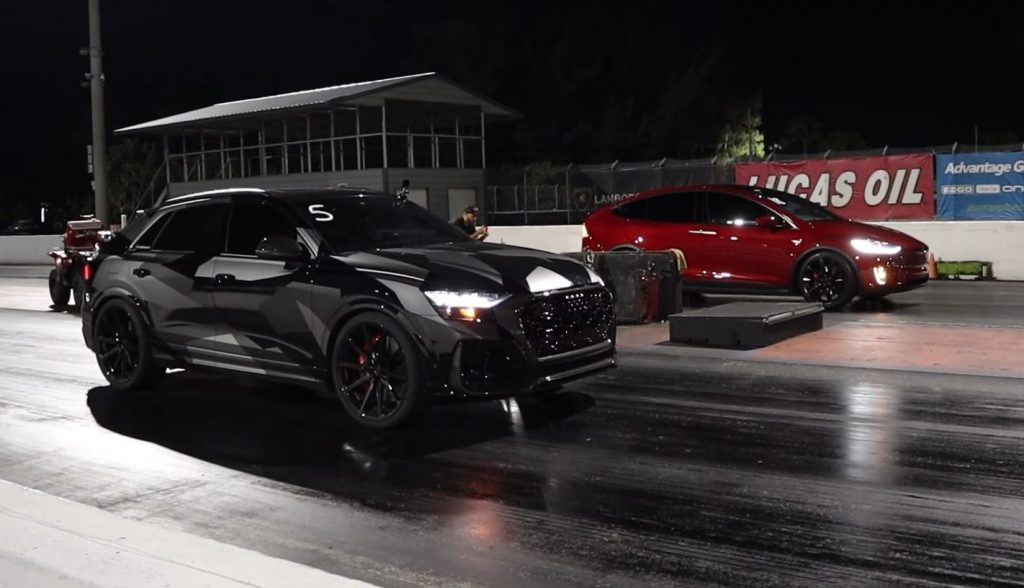
The second matchup was between the Audi RSQ8 vs Tesla’s 2016 Model X P100D. As we discussed earlier, the Tesla specs are better than the RSQ8. The modified Audi may outperform the Tesla but the torque numbers aren’t even close. More torque at the rear should ideally give the Tesla a great launch. Both the cars got off to a decent start in the first run. However, like the previous race, as the race progressed the RSQ8 flew off. The gap this time was extremely significant. Tabulated results of the drag race are as follows:
| MODEL | TOP SPEED (MPH) | QUARTER-MLE TIME (SECS) |
| AUDI RSQ8 | 119.75 | 11.370 |
| TESLA MODEL X P100D | 99.41 | 12.327 |
The gap is more than one second. The top speed achieved in the run had a disparity of more than 20 mph. This clearly reflects the time gap.
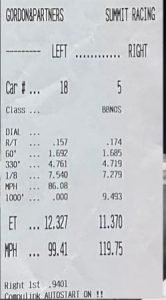
Second Run:
Torque at rear-end should ideally give Tesla an edge in the launch. However, in the second run, the Model X completely fluffed the launch. The story further was the same as the first run. Due to the poor start, the Audi RSQ8 thrashed the Model X in this run.
| MODEL | TOP SPEED (MPH) | QUARTER-MLE TIME (SECS) |
| AUDI RSQ8 | 119.68 | 11.361 |
| TESLA MODEL X P100D | 96.94 | 12.535 |
Again, the numbers are shocking.
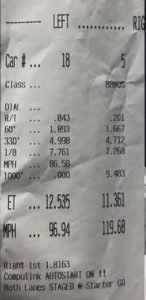
Reason Behind Tesla’s Disastrous Numbers and Tesla’s Disappointing Reply
The host of the video explained the problem with Tesla Model X. The Model X used was not the recent one. Hence, it did not have the Cheetah Mode. That said the Model was only four years old. We know that battery degradation is an issue with electric vehicles. But this isn’t generally seen within the first four years. The Model X had only 27,000 km on it. The Model X used for the video had 90% SOC. The same Model X had topped out at 119 mph just two years ago. The top speed this time didn’t even touch 100mph. Which means that the Model X lost 20mph of speed in two years. On running some calculation we can say that this loss in speed corresponds to 200-250 hp of power.
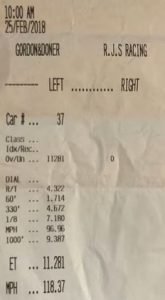
Naturally, this downgrade in performance forced the owner to meet Tesla. The owner was met with a disappointing reply. The two main problems were the loss of performance and discrepancies on the dashboard. In a conversation, the Tesla employee explained that they cannot help him with the lost performance. Tesla employees went on to explain that the Model X passed all the diagnostics (battery, motor, etc.) The owner provided DragTimes with the screenshots of the above conversation. Take a look for yourself:
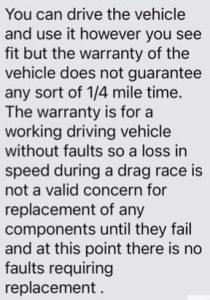
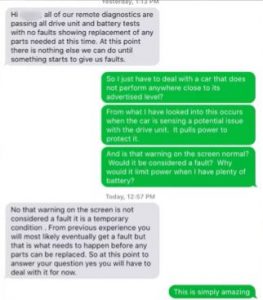
Conclusion
The modified Audi stood out as a top performer. Its performance was consistent throughout the three runs. The Model X P100D has definitely seen a massive loss in performance in two years. The reasons behind this are unknown. But one can speculate: Is it the software updates that limit performance? Are the batteries degrading faster than usual? Is Tesla right to turn away the doubts around loss in performance?
Let us know in the comments.




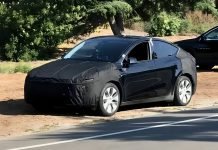













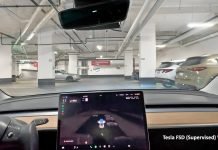
The problem is only internal resistance of the battery cells , on my old Tesla model S (2014) at full charge when I hit throttle I can see battery voltage drop to 300V ( some seconds before I have 400V) all the power losses is directly in the battery (it’s 100 kW of loss in the battery pack) and this power is also lost for the motors …
I‘m sorry, are you serious? Comparing a new, tuned car to a 4 year old EV? Who in God‘s name came up with this fantastic idea?
Ridiculos!